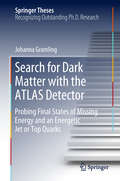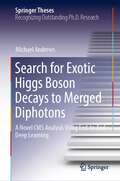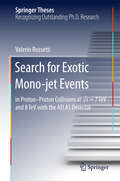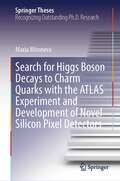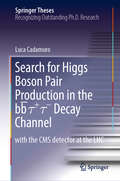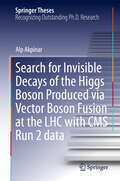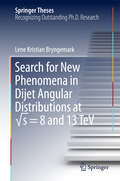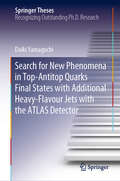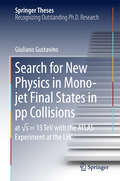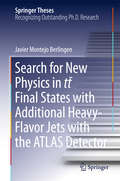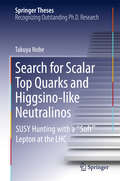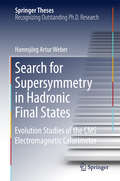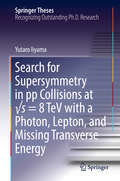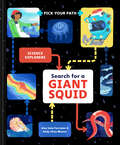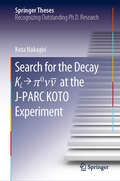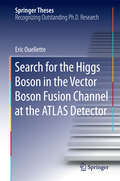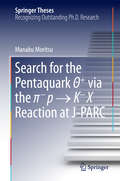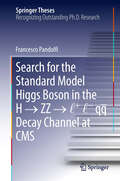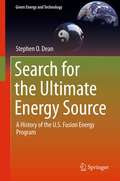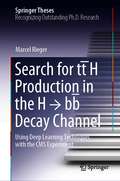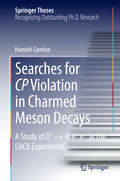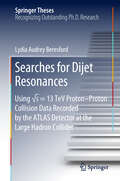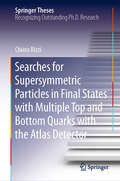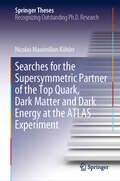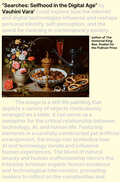- Table View
- List View
Search for Dark Matter with the ATLAS Detector: Probing Final States Of Missing Energy And An Energetic Jet Or Top Quarks (Springer Theses)
by Johanna GramlingThis book discusses searches for Dark Matter at the CERN’s LHC, the world’s most powerful accelerator. It introduces the relevant theoretical framework and includes an in-depth discussion of the Effective Field Theory approach to Dark Matter production and its validity, as well as an overview of the formalism of Simplified Dark Matter models. Despite overwhelming astrophysical evidence for Dark Matter and numerous experimental efforts to detect it, the nature of Dark Matter still remains a mystery and has become one of the hottest research topics in fundamental physics.Two searches for Dark Matter are presented, performed on data collected with the ATLAS experiment. They analyze missing-energy final states with a jet or with top quarks. The analyses are explained in detail, and the outcomes and their interpretations are discussed, also in view of the precedent analysis of theoretical approaches. Given its depth of coverage, the book represents an excellent reference guide for all physicists interested in understanding the theoretical and experimental considerations relevant to Dark Matter searches at the LHC.
Search for Exotic Higgs Boson Decays to Merged Diphotons: A Novel CMS Analysis Using End-to-End Deep Learning (Springer Theses)
by Michael AndrewsThis book describes the first application at CMS of deep learning algorithms trained directly on low-level, “raw” detector data, or so-called end-to-end physics reconstruction. Growing interest in searches for exotic new physics in the CMS collaboration at the Large Hadron Collider at CERN has highlighted the need for a new generation of particle reconstruction algorithms. For many exotic physics searches, sensitivity is constrained not by the ability to extract information from particle-level data but by inefficiencies in the reconstruction of the particle-level quantities themselves. The technique achieves a breakthrough in the reconstruction of highly merged photon pairs that are completely unresolved in the CMS detector. This newfound ability is used to perform the first direct search for exotic Higgs boson decays to a pair of hypothetical light scalar particles H→aa, each subsequently decaying to a pair of highly merged photons a→yy, an analysis once thought impossible to perform. The book concludes with an outlook on potential new exotic searches made accessible by this new reconstruction paradigm.
Search for Exotic Mono-jet Events
by Valerio RossettiThis thesis describes in detail the search for new phenomena in mono-jet final states with the ATLAS experiment at the LHC. The final state is considered the golden channel in the searches for large extra dimensions (LED) but also allows access to a very rich SUSY-related phenomenology pertaining to the production of weakly interacting massive particles (WIMPS), SUSY Dark Matter candidates, GMSB SUSY models with very light gravitino masses, as well as stop an sbottom pair production in compressed scenarios (with nearly degenerated squarks and the lightest neutralino), and also invisible Higgs searches, among others. Here, a number of these scenarios are explored. The measurements presented yield new powerful constraints on the existence of extra spatial dimensions, the pair production of WIMPs, and also provide the best limit to date on the gravitino mass.
Search for Higgs Boson Decays to Charm Quarks with the ATLAS Experiment and Development of Novel Silicon Pixel Detectors (Springer Theses)
by Maria MironovaThis book explores the Higgs boson and its interactions with fermions, as well as the detector technologies used to measure it. The Standard Model of Particle Physics has been a groundbreaking theory in our understanding of the fundamental properties of the universe, but it is incomplete, and there are significant hints which require new physics. The discovery of the Higgs boson in 2012 was a substantial confirmation of the Standard Model, but many of its decay modes remain elusive. This book presents the latest search for Higgs boson decays into c-quarks using a proton-proton collision dataset collected by the ATLAS experiment at the Large Hadron Collider (LHC). This decay mode has yet to be observed and requires advanced machine learning algorithms to identify c-quarks in the experiment. The results provide an upper limit on the rate of Higgs boson decays to c-quarks and a direct measurement of the Higgs boson coupling strength to c-quarks. The book also discusses the future of particle physics and the need for significant improvements to the detector to cope with increased radiation damage and higher data rates at the High-Luminosity LHC. It presents the characterization of the ATLAS pixel detector readout chip for the inner detector upgrade (ITk). The chip was subjected to irradiations using X-rays and protons to simulate the radiation environment at the HL-LHC. The tests showed that all readout chip components, including the digital logic and analogue front-end, are sufficiently radiation-tolerant to withstand the expected radiation dose. Finally, this book describes monolithic pixel detectors as a possible technology for future pixel detectors. This book is ideal for individuals interested in exploring particle physics, the Higgs boson, and the development of silicon pixel detectors.
Search for Higgs Boson Pair Production in the bb̅ τ+ τ- Decay Channel: with the CMS detector at the LHC (Springer Theses)
by Luca CadamuroThis thesis presents innovative contributions to the CMS experiment in the new trigger system for the restart of the LHC collisions in Run II, as well as original analysis methods and important results that led to official publications of the Collaboration.The author's novel reconstruction algorithms, deployed on the Field-Programmable Gate Arrays of the new CMS trigger architecture, have brought a gain of over a factor 2 in efficiency for the identification of tau leptons, with a very significant impact on important H boson measurements, such as its decays to tau lepton pairs and the search for H boson pair production.He also describes a novel analysis of HH → bb tautau, a high priority physics topic in a difficult channel. The original strategy, optimisation of event categories, and the control of the background have made the result one of the most sensitive concerning the self-coupling of the Higgs boson among all possible channels at the LHC.
Search for Invisible Decays of the Higgs Boson Produced via Vector Boson Fusion at the LHC with CMS Run 2 data (Springer Theses)
by Alp AkpinarThis thesis reports the latest measurements on one of the leading dark matter searches conducted by the Compact Muon Solenoid (CMS) experiment at CERN, leading to some of the most stringent constraints on hypothesized interactions between the Higgs boson and dark matter. The thesis also includes further research about the future outlook of the experiment, including exploratory research on the adaptation of deep learning models in future dark matter analyses to improve analysis sensitivity, and the design of a new type of data processing hardware to be used in the next phase of the CMS experiment.
Search for New Phenomena in Dijet Angular Distributions at √s = 8 and 13 TeV (Springer Theses)
by Lene Kristian BryngemarkThis thesis describes the use of the angular distributions of the most energetic dijets in data recorded by the ATLAS experiment, at CERN's Large Hadron Collider (LHC), the goal of which is to search for phenomena beyond what the current theory of Particle Physics (the Standard Model) can describe. It also describes the deployment of the method used in ATLAS to correct for the distortions in jet energy measurements caused by additional proton-proton interactions. The thesis provides a detailed introduction to understanding jets and dijet searches at the LHC. The experiments were carried out at two record collider centre-of-mass energies (8 and 13 TeV), probing smaller distances than ever before. Across a broad momentum transfer range, the proton constituents (quarks and gluons) display the same kinematical behaviour, and thus still appear to be point-like. Data are compared to predictions corrected for next-to-leading order quantum chromodynamics (NLO QCD) as well as electroweak effects, demonstrating excellent agreement. The results are subsequently used to set limits on parameters of suggested theoretical extensions to the Standard Model (SM), including the effective coupling and mass of a Dark Matter mediator.
Search for New Phenomena in Top-Antitop Quarks Final States with Additional Heavy-Flavour Jets with the ATLAS Detector (Springer Theses)
by Daiki YamaguchiThis book reports on the search for a new heavy particle, the Vector-Like Top quark (VLT), in the Large Hadron Collider (LHC) at CERN. The signal process is the pair production of VLT decaying into a Higgs boson and top quark (TT→Ht+X, X=Ht, Wb, Zt). The signal events result in top–antitop quarks final states with additional heavy flavour jets. The book summarises the analysis of the data collected with the ATLAS detector in 2015 and 2016. In order to better differentiate between signals and backgrounds, exclusive taggers of top quark and Higgs boson were developed and optimised for VLT signals. These efforts improved the sensitivity by roughly 30%, compared to the previous analysis. The analysis outcomes yield the strongest constraints on parameter space in various BSM theoretical models. In addition, the book addresses detector operation and the evaluation of tracking performance. These efforts are essential to properly collecting dense events and improving the accuracy of the reconstructed objects that are used for particle identification. As such, they represent a valuable contribution to data analysis in extremely dense environments.
Search for New Physics in Mono-jet Final States in pp Collisions
by Giuliano GustavinoThis thesis provides a detailed and comprehensive description of the search for New Physics at the Large Hadron Collider (LHC) in the mono-jet final state, using the first 3. 2 fb$^{{-1}}$ of data collected at the centre of mass energy of colliding protons of 13 TeV recorded in the ATLAS experiment at LHC. The results are interpreted as limits in different theoretical contexts such as compressed supersymmetric models, theories that foresee extra-spatial dimensions and in the dark matter scenario. In the latter the limits are then compared with those obtained by other ATLAS analyses and by experiments based on completely different experimental techniques, highlighting the role of the mono-jet results in the context of dark matter searches. Lastly, a set of possible analysis improvements are proposed to reduce the main uncertainties that affect the signal region and to increase the discovery potential by further exploiting the information on the final state.
Search for New Physics in tt Final States with Additional Heavy-Flavor Jets with the ATLAS Detector
by Javier Montejo BerlingenThis doctoral thesis focuses on the search for new phenomena in top-antitop quark (tt) final states with additional b-quark jets at the LHC. It uses the full Run 1 dataset collected by the ATLAS experiment in proton-proton collisions at √s=8 TeV. The final state of interest consists of an isolated lepton, a neutrino and at least six jets with at least four b-tagged jets, a challenging experimental signature owing to the large background from tt+heavy-flavor production. This final state is characteristic of ttH production, with the Higgs boson decaying into bb, a process that allows direct probing of the top-Higgs Yukawa coupling. This signature is also present in many extensions of the Standard Model that have been proposed as solutions to the hierarchy problem, such as supersymmetry or composite Higgs models, which predict the pair production of bosonic or fermionic top quark partners, or the anomalous production of four-top-quark events. All these physics processes have been searched for using an ambitious search strategy that has been developed on the basis of a combination of state-of-art theoretical predictions and a sophisticated statistical analysis to constrain in-situ the large background uncertainties. As a result, the most restrictive bounds to date on the above physics processes have been obtained.
Search for Scalar Top Quarks and Higgsino-Like Neutralinos
by Takuya NobeThis book reports a search for theoretically natural supersymmetry (SUSY) at the Large Hadron Collider (LHC). The data collected with the ATLAS detector in 2012 corresponding to 20 /fb of an integrated luminosity have been analyzed for stop pair production in proton-proton collisions at a center-of-mass energy of 8 TeV at the Large Hadron Collider (LHC) in the scenario of the higgsino-like neutralino. The author focuses on stop decaying into a bottom quark and chargino. In the scenario of the higgsino-like neutralino, the mass difference between charginos and neutralinos (Δm) is expected to be small, and observable final-state particles are likely to have low-momentum (soft). The author develops a dedicated analysis with a soft lepton as a probe of particles from chargino decay, which suppresses the large amount of backgrounds. As a result of the analysis, no significant SUSY signal is observed. The 95% confidence-level exclusion limits are set to masses of stop and neutralino assuming Δm = 20 GeV. The region with ΔM (the mass difference between stop and neutralino) 120 GeV up to 600 GeV of stop mass with neutralino mass of less than 280 GeV. The author clearly shows very few remaining parameter spaces for light stop (e. g. , topology of stop decay is extremely similar to the SM top quark) by combining his results and previous ATLAS analyses. His results provide a strong constraint to searches for new physics in the future.
Search for Supersymmetry in Hadronic Final States
by Hannsjörg Artur WeberThe project reported here was a search for new super symmetric particles in proton-proton collisions at the LHC. It has produced some of the world's best exclusion limits on such new particles. Furthermore, dedicated simulation studies and data analyses have also yielded essential input to the upgrade activities of the CMS collaboration, both for the Phase-1 pixel detector upgrade and for the R&D studies in pursuit of a Phase-2 end cap calorimeter upgrade.
Search for Supersymmetry in pp Collisions at √s = 8 TeV with a Photon, Lepton, and Missing Transverse Energy
by Yutaro IiyamaThis Ph. D. thesis is a search for physics beyond the standard model (SM) of particle physics, which successfully describes the interactions and properties of all known elementary particles. However, no particle exists in the SM that can account for the dark matter, which makes up about one quarter of the energy-mass content of the universe. Understanding the nature of dark matter is one goal of the CERN Large Hadron Collider (LHC). The extension of the SM with supersymmetry (SUSY) is considered a promising possibilities to explain dark matter. The nominated thesis describes a search for SUSY using data collected by the CMS experiment at the LHC. It utilizes a final state consisting of a photon, a lepton, and a large momentum imbalance probing a class of SUSY models that has not yet been studied extensively. The thesis stands out not only due to its content that is explained with clarity but also because the author performed more or less all aspects of the thesis analysis by himself, from data skimming to limit calculations, which is extremely rare, especially nowadays in the large LHC collaborations.
Search for a Giant Squid: Pick Your Path (Science Explorers)
by Amy Seto ForresterA new and exciting pick-your-path STEM adventure for emerging readers! <P><P> This series starter takes emerging readers on an expedition to the ocean's twilight zone in search of a giant squid. But giant squids are hard to find. Readers will need to join the expedition and help make choices along the way. <P><P> First they'll pick their submersible. And then their pilot and dive site. They'll need to be careful—not every path leads where it seems, but whatever path they pick, they';ll see and learn amazing things! <P><P> This introduction to the career of marine zoologist, and the other members of a deep-sea expedition, lets readers dip their toes into being a teuthologist—a scientist who studies cephalopods such as octopus and squid. <P><P><i>Advisory: Bookshare has learned that this book offers only partial accessibility. We have kept it in the collection because it is useful for some of our members. Benetech is actively working on projects to improve accessibility issues such as these.</i>
Search for the Decay K_L → π^0\nu\bar{\nu} at the J-PARC KOTO Experiment (Springer Theses)
by Kota NakagiriThis book reports on a new result from the KL→π0νν search at the J-PARC KOTO experiment, which sets an upper limit of 3×10-9 for the branching fraction of the decay at the 90% confidence level, improving the previous best limit by an order of magnitude. To explain the matter–antimatter asymmetry in the universe, still unknown new physics beyond the standard model (SM) that breaks CP symmetry is necessary. The rare decay of a long-lived neutral K meson, KL→π0νν, is a CP-violating decay. It is an excellent probe to search for new physics because new physics can contribute to the decay and change its branching fraction, while the SM is as small as 3×10-11. However, it is extremely difficult to search for because all of the decay products are neutral and two neutrinos are undetectable. The KL→π0νν signal is identified by measuring two photons from a π0 with a calorimeter and confirming the absence of any other detectable particles with hermetic veto counters. The book contributes to the analysis of neutron-induced backgrounds which were the dominant background sources in the search. For the background caused by two consecutive hadronic showers in the calorimeter due to a neutron, the author evaluated the background yield using a data-driven approach. For another background caused by an η meson production—η decays two photons—by a neutron that hits a veto counter near the calorimeter, the author developed an original analysis technique to reduce it. The book also contributes to the analysis of the normalization modes (KL→3π0, KL→2π0, KL→2γ) to measure KL yield, the estimation of the signal acceptance based on a simulation, and the evaluation of the trigger efficiency. As a result, significant improvements in the measurement were achieved, and this is an important step in the continuing higher sensitivity search, which can reach new physics with the energy scales up to O(100-1000 TeV).
Search for the Higgs Boson in the Vector Boson Fusion Channel at the ATLAS Detector
by Eric OuelletteThis Thesis describes the first measurement of, and constraints on, Higgs boson production in the vector boson fusion mode, where the Higgs decays to b quarks (the most common decay channel), at the LHC. The vector boson fusion mode, in which the Higgs is produced simultaneously with a pair of quark jets, provides an unparalleled opportunity to study the detailed properties of the Higgs, including the possibility of parity and CP violation, as well as its couplings and mass. It thus opens up this new field of study for precision investigation as the LHC increases in energy and intensity, leading the way to this new and exciting arena of precision Higgs research.
Search for the Pentaquark Θ+ via the π--p K--X Reaction at J-PARC
by Manabu MoritsuThistheses reports on an experimental search for an exotic hadron, &ThΗ+(1540)pentaquark, which is a genuine exotic hadron with a five-quark system of uuddsbar. Theresults of this book support that the existence of &ThΗ+ wasstrongly constrained. The &ThΗ+ pentaquark was searched for via the Π- p ⇒ K- Xreaction using a beam momentum of 2. 01 GeV/c at the J-PARC hadron experimentalfacility, taking advantage of high-statistics and high-resolution compared withprevious experiments, some of which claimed the evidence of &ThΗ+. Inorder to realize a good missing-mass resolution of 2 MeV, the beam spectrometerand superconducting kaon spectrometer were constructed. No clear peak was observed in the missing mass spectrum of the Π- p ⇒ K- Xreaction, and the upper limit of the production cross section was found to beless than 0. 28 Μb/sr at the 90% confidence level in a mass region of1500-1560 MeV/c2. This upper limit is an order of magnitude smallerthan that of the previous KEK experiment. Compared with a theoreticalcalculation using the effective Lagrangian approach, the decay width of &ThΗ+ wasevaluated. The upper limits on the decay width were estimated to be 0. 36 and1. 9 MeV for the &ThΗ+ spin-parity of 1/2+ and 1/2-,respectively. These are quite small for a width of ordinary hadron resonances,and the existence of &ThΗ+ was strongly constrained and isdoubtful.
Search for the Standard Model Higgs Boson in the H → ZZ → l + l - qq Decay Channel at CMS
by Francesco PandolfiThe theoretical foundations of the Standard Model of elementary particles relies on the existence of the Higgs boson, a particle which has been revealed for the first time by the experiments run at the Large Hadron Collider (LHC) in 2012. As the Higgs boson is an unstable particle, its search strategies were based on its decay products. In this thesis, Francesco Pandolfi conducted a search for the Higgs boson in the H ZZ l + l - qq Decay Channel with 4.6 fb -1 of 7 TeV proton-proton collision data collected by the Compact Muon Solenoid (CMS) experiment. The presence of jets in the final state poses a series of challenges to the experimenter: both from a technical point of view, as jets are complex objects and necessitate of ad-hoc reconstruction techniques, and from an analytical one, as backgrounds with jets are copious at hadron colliders, therefore analyses must obtain high degrees of background rejection in order to achieve competitive sensitivity. This is accomplished by following two directives: the use of an angular likelihood discriminant, capable of discriminating events likely to originate from the decay of a scalar boson from non-resonant backgrounds, and by using jet parton flavor tagging, selecting jets compatible with quark hadronization and discarding jets more likely to be initiated by gluons. The events passing the selection requirements in 4.6 fb -1 of datacollected by the CMS detector are examined, in the search of a possible signal compatible with the decay of a heavy Higgs boson. The thesis describes the statistical tools and the results of this analysis. This work is a paradigm for studies of the Higgs boson with final states with jets. The non-expert physicists will enjoy a complete and eminently readable description of a proton-proton collider analysis. At the same time, the expert reader will learn the details of the searches done with jets at CMS.
Search for the Ultimate Energy Source
by Stephen O. DeanWhy has the clean, limitless energy promised by fusion always seemed just out of reach? Search for the Ultimate Energy Source: A History of the U.S. Fusion Energy Program, explains the fundamentals and concepts behind fusion power, and traces the development of fusion historically by decade--covering its history as dictated by US government policies, its major successes, and its prognosis for the future. The reader will gain an understanding of how the development of fusion has been shaped by changing government priorities as well as other hurdles currently facing realization of fusion power. Advance Praise for Search for the Ultimate Energy Source: "Dr. Dean has been uniquely involved in world fusion research for decades and, in this book, describes the complicated realities like few others possibly could." -Robert L. Hirsch, a former director of the US fusion program, an Assistant Administrator of the US Energy Research and Development Administration (ERDA); an executive at Exxon, Arco, and the Electric Power Research Institute (EPRI); and lead author of the book The Impending World Energy Mess (Apogee Prime Books, 2009). "In this book, Dr. Dean provides the many reasons why fusion has progressed more slowly than many had hoped. Budget is usually cited as the culprit, but policy is equally to blame. Facilities have been closed down before their jobs were done--or in some cases, even started. It seems this situation has become endemic in fusion, and if one thinks about it, in other nationally important Science and Technology initiatives as well." -William R. Ellis, a former scientist at Los Alamos National Laboratory, Associate Director of Research at the US Naval Research Laboratory, a vice president at Ebasco Services and at Raytheon, and chair of the US ITER Industry Council and the US ITER Industrial Consortium.
Search for tt̄H Production in the H → bb̅ Decay Channel: Using Deep Learning Techniques with the CMS Experiment (Springer Theses)
by Marcel RiegerIn 1964, a mechanism explaining the origin of particle masses was proposed by Robert Brout, François Englert, and Peter W. Higgs. 48 years later, in 2012, the so-called Higgs boson was discovered in proton-proton collisions recorded by experiments at the LHC. Since then, its ability to interact with quarks remained experimentally unconfirmed. This book presents a search for Higgs bosons produced in association with top quarks tt̄H in data recorded with the CMS detector in 2016. It focuses on Higgs boson decays into bottom quarks H → bb̅ and top quark pair decays involving at least one lepton. In this analysis, a multiclass classification approach using deep learning techniques was applied for the first time. In light of the dominant background contribution from tt̄ production, the developed method proved to achieve superior sensitivity with respect to existing techniques. In combination with searches in different decay channels, the presented work contributed to the first observations of tt̄H production and H → bb̅ decays.
Searches for CP Violation in Charmed Meson Decays
by Hamish GordonOur current understanding of the fundamental building blocks of the Universe, summarised by the Standard Model of particle physics, is incomplete. For example, it fails to explain why we do not see equal, or almost equal, numbers of particles and their antiparticle partners. To explain this asymmetry requires, among other effects, a mechanism known as charge-parity (CP) violation that causes differences between the rates at which particles and antiparticles decay. CP violation is seen in systems containing bottom and strange quarks, but not in those with up, charm or top quarks. This thesis describes searches for particle-antiparticle asymmetries in the decay rates of charmed mesons. No evidence of CP violation is found. With current sensitivities, an asymmetry large enough to observe probably could not be explained by the Standard Model. Instead an explanation could come from new physics, for example contributions from supersymmetric or other undiscovered heavy particles. In the thesis, the development of new techniques to search for these asymmetries is described. They are applied to data from the LHCb experiment at CERN to make precise measurements of asymmetries in the D^+->K^-K^+pi^+ decay channel. This is the most promising charged D decay for CP violation searches.
Searches for Dijet Resonances: Using ?s = 13 Tev Proton- Proton Collision Data Recorded By The Atlas Detector At The Large Hadron Collider (Springer Theses)
by Lydia Audrey BeresfordThis book addresses one of the most intriguing mysteries of our universe: the nature of dark matter. The results presented here mark a significant and substantial contribution to the search for new physics, in particular for new particles that couple to dark matter. The first analysis presented is a search for heavy new particles that decay into pairs of hadronic jets (dijets). This pioneering analysis explores unprecedented dijet invariant masses, reaching nearly 7 TeV, and sets constraints on several important new physics models. The two subsequent analyses focus on the difficult low dijet mass region, down to 200 GeV, and employ a novel technique to efficiently gather low-mass dijet events. The results of these analyses transcend the long-standing constraints on dark matter mediator particles set by several existing experiments.
Searches for Supersymmetric Particles in Final States with Multiple Top and Bottom Quarks with the Atlas Detector (Springer Theses)
by Chiara RizziThis PhD thesis documents two of the highest-profile searches for supersymmetry performed at the ATLAS experiment using up to 80/fb of proton-proton collision data at a center-of-mass energy of 13 TeV delivered by the Large Hadron Collider (LHC) during its Run 2 (2015-2018). The signals of interest feature a high multiplicity of jets originating from the hadronisation of b-quarks and large missing transverse momentum, which constitutes one of the most promising final state signatures for discovery of new phenomena at the LHC. The first search is focused on the strong production of a pair of gluinos, with each gluino decaying into a neutralino and a top-antitop-quark pair or a bottom-antibottom-quark pair. The second search targets the pair production of higgsinos, with each higgsino decaying into a gravitino and a Higgs boson, which in turn is required to decay into a bottom-antibottom-quark pair. Both searches employ state-of-the-art experimental techniques and analysis strategies at the LHC, resulting in some of the most restrictive bounds available to date on the masses of the gluino,neutralino, and higgsino in the context of the models explored.
Searches for the Supersymmetric Partner of the Top Quark, Dark Matter and Dark Energy at the ATLAS Experiment (Springer Theses)
by Nicolas Maximilian KöhlerAstrophysical observations implying the existence of Dark Matter and Dark Energy, which are not described by the Standard Model (SM) of particle physics, have led to extensions of the SM predicting new particles that could be directly produced at the Large Hadron Collider (LHC) at CERN. Based on 2015 and 2016 ATLAS proton-proton collision data, this thesis presents searches for the supersymmetric partner of the top quark, for Dark Matter, and for DarkEnergy, in signatures with jets and missing transverse energy.Muon detection is key to some of the most important LHC physics results, including the discovery of the Higgs boson and the measurement of its properties. The efficiency with which muons can be detected with the ATLAS detector is measured using Z boson decays. The performance of high-precision Monitored Drift Tube muon chambers under background rates similar to the ones expected for the High Luminosity-LHC is studied.
Searches: Selfhood in the Digital Age
by Vauhini VaraFrom the author of The Immortal King Rao, finalist for the Pulitzer Prize, a personal exploration of how technology companies have both fulfilled and exploited the human desire for understanding and connectionA MOST ANTICIPATED BOOK: The New York Times, Esquire, Harper&’s Bazaar, Foreign Policy, Bustle, Alta, Ms. Magazine, Cultured, Denizen, Lit Hub, Book Riot, and Electric LiteratureWhen it was released to the public in November 2022, ChatGPT awakened the world to a secretive project: teaching AI-powered machines to write. Its creators had a sweeping ambition—to build machines that could not only communicate, but could do all kinds of other activities, better than humans ever could. But was this goal actually achievable? And if reached, would it lead to our liberation or our subjugation? Vauhini Vara, an award-winning tech journalist and editor, had long been grappling with these questions. In 2021, she asked a predecessor of ChatGPT to write about her sister&’s death, resulting in an essay that was both more moving and more disturbing than she could have imagined. It quickly went viral.The experience, revealing both the power and the danger of corporate-owned technologies, forced Vara to interrogate how these technologies have influenced her understanding of her self and the world around her, from discovering online chat rooms as a preteen, to using social media as the Wall Street Journal&’s first Facebook reporter, to asking ChatGPT for writing advice—while compelling her to add to the trove of human-created material exploited for corporations&’ financial gain. Interspersed throughout this investigation are her own Google searches, Amazon reviews, and the other raw material of internet life—including the viral AI experiment that started it all. Searches illuminates how technological capitalism is both shaping and exploiting human existence, while proposing that by harnessing the collective creativity that makes humans unique, we might imagine a freer, more empowered relationship with our machines and, ultimately, with one another.
